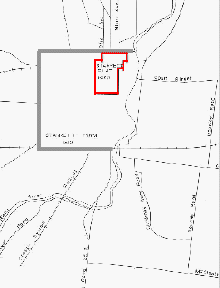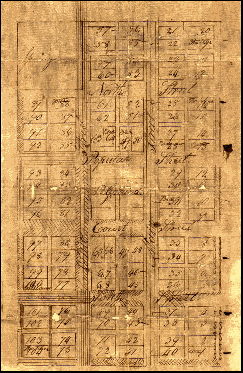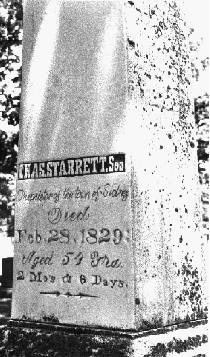|
Feature on Charles Starrett. Topic: PEOPLE &
PIONEER
Written by Barbara Adams & Jim Sayre in January, 1998
SIDNEY'S FOUNDER MAKES LAND
DONATION |
| Sidney is named for the 16th century English
poet-patriot, Sir Philip Sidney. But, a
myth persists that our city was named for its founder in 1820, Charles Starrett, whose
middle name is often rumored to be Sidney. It is no myth, though, that his role in
establishing Sidney made him very wealthy. Basis for the middle name rumor are published
works, some in the 1920’s, calling him Charles Sidney Starrett.
A special Sidney
Daily News edition in August 1927, while affirming Sir Philip’s role, muddied the
waters by noting that..."It was in honor of Sir Philip that his namesake, Charles
Sidney Starrett, donor of the town plat, affixed his name." In fact, "Charles
Sidney Starrett Donor of the Town Plot" was part of the article’s headline. An
accompanying photograph of the old Starrett home, which stood at the former Erb lumberyard
site on South Walnut near Starrett’s Run, carried this caption: "...the
home of Charles Sidney Starrett..."
A recent article, again agreeing to the Sir Philip connection, nonetheless left open
the door of confusion with this: "Charles Sidney Starrett, who blew the winds of
life into our town’s humble beginning..." (Shelby County Historical Society
newsletter insert, July 1997).
What started the Sidney name myth may have been this passage in Memoirs
of the Miami Valley published 100 years after Sidney was founded: "It was in
Sir Philip’s honor that his namesake Charles Sidney Starrett, donor the of town plat,
affixed the name of Sidney thereto" (Robt. O. Law Co., 1919). |

This is a map of
Starrett’s farm. The gray is the farm boundary on the west, while the red is the 70
acre donation which made up area of what is now known as Sidney, Ohio.
|
Local genealogists can find no name record
other than simply "Charles Starrett,"
although the known facts of Charles Starrett’s life are meager. In fact, executors of
the will of Mr. Starrett’s father wrote him off as a beneficiary, noting that he
probably died in Kentucky. No, he died In Ohio and was buried in Sidney...at least twice.
First
laid to rest in the old Presbyterian Cemetery, his body was removed when the high school,
now Bridgeview, was built in 1912, according to the late Shelby County historian Paul
Sherman. But was Starrett first buried in the old Starrett cemetery, now the triangular Schultz’ Battery Memorial park at
the divergence of South Main and South Ohio streets? This is the claim of a Starrett
researcher of the same name but different branch of the family, Bill Starrett of
Indianapolis and formerly of Sidney. But, for sure, Charles Starrett now lies beneath a
Graceland Cemetery memorial of dimensions befitting a town’s father.
Local historians believe that a sharp investor like Starrett would have specified his
name in the Sidney land agreement if indeed his middle name had been Sidney and had
he wanted the town named for him. In short, he covered all the angles. But, there is no
such clause.
Starrett’s land was chosen for Sidney in 1819 after a short trial seat of justice
at Hardin, mainly because the Great
Miami River site was more centrally located in the county. And, Mr. Starrett was ready to
deal. He offered his land for the town, but he made sure that the county seat would
permanently remain there and he wanted half the proceeds from the sale of lots.
Agreement came quickly and 113 lots were laid out in the original plat.

This is a map of the
downtown portion of Charles Starrett’s donation. It is the original town plot.
[Note:
Lots #105-113 are not shown on this drawing]
The official document of the land deal read,
in part... "I, the undersigned subscriber....do make a donation to the
Commissioners of Shelby County of seventy acres of land...to fix said seat (of justice) in
said fraction...provided that I do receive one-half of the proceeds of the sales of the
lots..." And, it was signed "Charles Sterrett," with a slight
variation in spelling, but no middle name.
A resident of Virginia, Starrett in 1809 had
applied for the purchase of 508 acres of Miami County land, later a part of Shelby County.
The transaction was completed in 1812 with a government land patent made out to
"Charles Sterrett," no middle name nor initial. He likely paid the going rate
for that time and location of $1.25 per acre, totaling $87.50 for the 70 acres
"donated" for the town of Sidney.
Some donation! The early Shelby County land speculator reportedly realized more than
$3,000 from the sale of the Sidney lots, thereby netting him about $2,900, or nearly 3,000
percent, on the deal. At today’s Shelby County land prices, this one transaction
would have netted Starrett in excess of $3 million and, of course, there were no capital
gains taxes back then to diminish the earnings.
Certainly a sharp real estate dealer but also public spirited, Starrett stipulated that
one acre be set aside for a public square, two half acres for two different denominations
of religious societies, one acre for each of two different denominations for cemeteries,
and one acre for schools. He
also conceded all springs within the property for the use of the town and "the
privilege of conveyance to the town" (Sutton’s History of Shelby County).
He initialed this clause with a simple "C.S.," not "C.S.S."

Mr. Starrett's tombstone
can be found near a large tree in Section 1 of Graceland Cemetery.
Further indication that Sir Philip, not
Starrett, was Sidney’s namesake comes in a May 3, 1820, letter written by Thomas W.
Ruckman, early surveyor of Sidney and later clerk to the county commissioners, county
auditor, and adjutant to the local militia. To his brother, he wrote: "I shall now
state that our County Seat is now finally Established on Mr. Sterats farm. The Court
Sanctioned the decision of the Commissioners at december court last winter and appointed David Henry, Capt., Director (Director of the town of Sidney) to lay off the town & sell the lotts. The
town was laid off by the 13th of March and named Sydney by the Court after a great
Political writer."
If we assume that Mr. Starrett was not that "great
Political writer," this early and first person account of the Sidney name origin
seems irrefutable, except for the short-lived double-y spelling (see Early newspaper
published in ‘Sydney,’ Sidney Daily News, April 5, 1997).
Ruckman gave another interesting perspective on real estate prices on the first sale of
lots: "The highest lot went to 239 dollars & several 200 and upwards. The
lowest about forty--the terms was 1 fourth in 90 days, l fourth in 9 months, 1 fourth in
15 months & the remaining fourth in two years."
The late William A. Ross, Jr., of Sidney had few clues to aid his frustrating search
for Charles Starrett’s history. What little he had was found in Charles’ estate
settlement. In the list of debts owed to the estate, one item gave this information...
"A letter from John Todd, Executor of the Estate of Charles Starrett’s father
acknowledging that there was one hundred pounds (entered in the settlement listing as
$333.33) willed to said Charles by his father, letter dated May 26th 1818..."
The wills of Charles’ parents, Robert and Elizabeth Starrett, though written in
Augusta County, Virginia, were eventually found in Butler County, Kentucky. Both wills
confirmed that their second child was indeed Charles Starrett of Sidney, Ohio, fame, but
no middle name nor initial appeared. Robert’s will read, in part: "I give and
bequeath to my son Charles Sterrit one hundred pounds more than he has received."
A Starrett descendant, the late Duncan H. McIntosh of Richmond, Virginia, researched
the family in 1963 and concluded that there was "No record of Charles. He could
have lived in Kentucky and died there." Charles Starrett was born in Ireland in
1774 and lived in Virginia before coming to Ohio, but historians can find few details. He
was married twice, his first wife having died. Of the seven children fathered by Mr.
Starrett, only one, Charles Jr., who died in 1853, maintained the family line. In 1871,
his wife and son, Charles Horace Starrett set out for Kansas and Missouri, leaving Sidney
bereft of the city founder’s descendants, although a number of Starretts of another
branch of the family live in Shelby County.
Charles Horace Starrett, married in 1884, named one of his five children Charles Sidney Starrett, probably in honor of his family’s historical connection with Shelby
County’s seat. The name of this fourth generation son may have contributed to the
middle name myth. Perhaps one factor compromising research into the family has been the
numerous spellings of the name: Sterrit, Sterritt, Sterrett, Starret, Starrett, but the
latter has been accepted in Sidney, a fact confirmed by Charles’ rather imposing
Washington Monument style gravemarker in Sidney’s Graceland Cemetery.
Noting the passing of "Chas. Starrett,
Sr." on February 28, 1829, the monument marks the life of a man short on recorded
personal history, but long on public accomplishment.Myths tend to build around important
figures of history where facts are sketchy or missing altogether. The middle name Sidney for Charles Starrett is just such a case. But, it is no myth that he influenced the early
settlement of Shelby County more than any other man, especially Sir Philip for whom Sidney is named, but who missed seeing it
by several centuries and quite a few thousand miles.

This is but one of the
many lumber companies which were located near the site of Charles Starrett’s original
homestead.
The above picture is of Klipstine Lumber, ca. 1909.
[ Back to People Index ]
|

